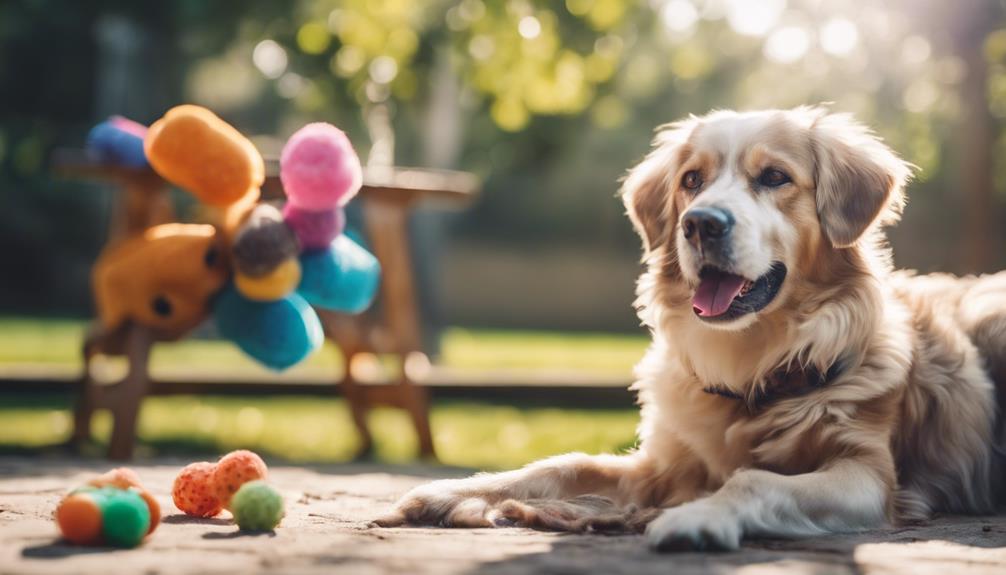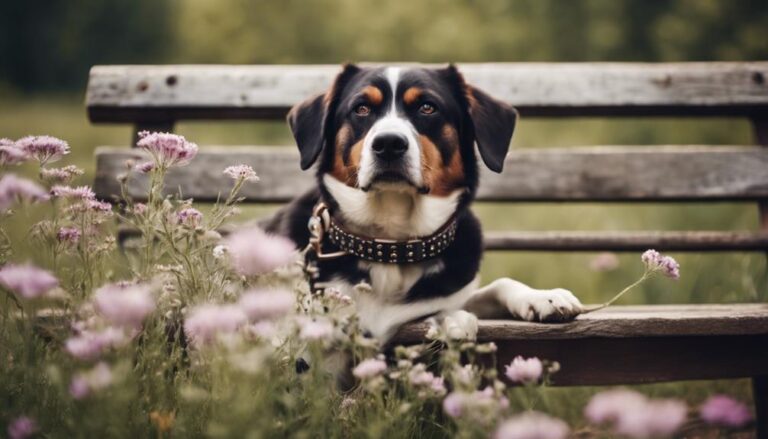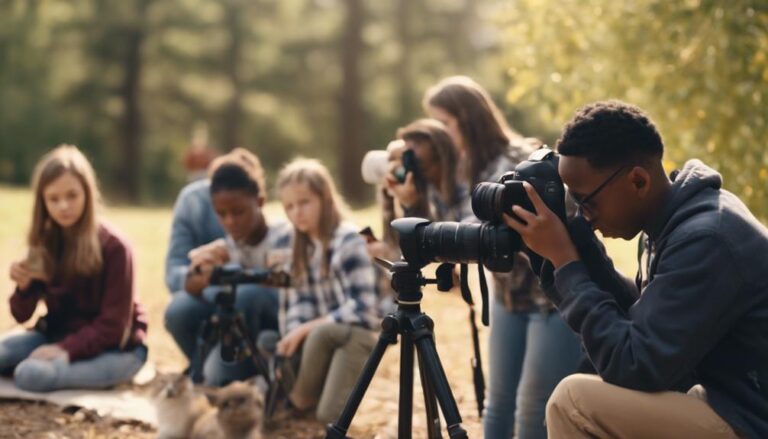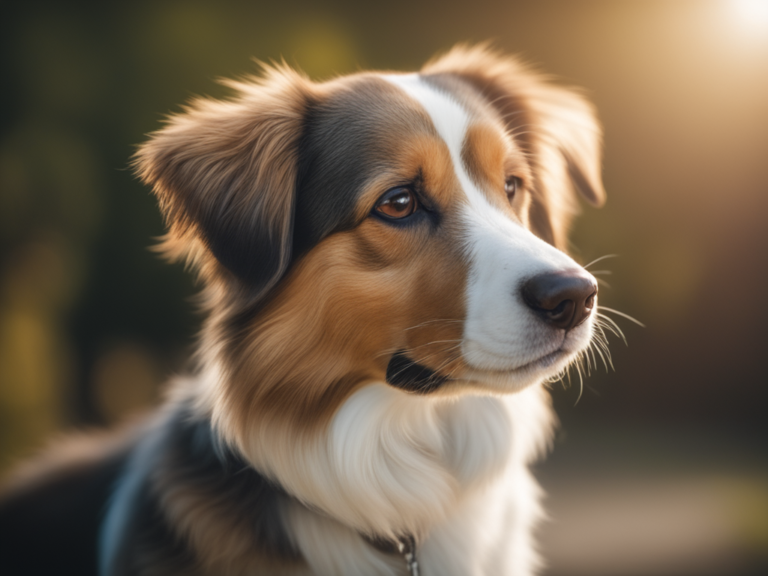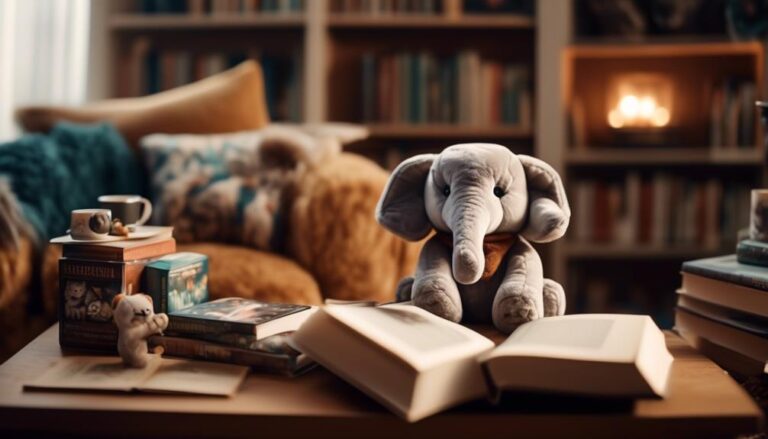Enhance your pet photography career with these expert tips and tricks: master camera settings for professional results, utilize natural light for stunning shots, invest in quality lenses, and understand pet behavior for mesmerizing portraits. Location scouting and creating a pet-friendly environment are key for successful shoots. Focus on composition, poses, and expressions to create visually appealing images. Strengthen client communication and manage expectations during sessions. Build a diverse portfolio showcasing your creativity and technical skills. Additionally, selecting the best pet models and capturing unique styles will set you apart in the pet photography industry. Elevate your career with these expert strategies.
Gear Essentials
When embarking on a career in pet photography, having the right gear essentials is crucial for capturing high-quality images of your furry subjects. Two important elements to ponder are backup storage and camera settings.
Firstly, let's discuss backup storage. When you're out on a shoot, the last thing you want is to run out of space on your memory card. Always carry extra memory cards or an external hard drive to make sure you never miss a precious moment with your adorable pet clients. Backup storage is not just about quantity but also about reliability. Invest in high-quality storage devices to safeguard your valuable work.
Next, mastering your camera settings is essential for achieving professional results. Understand the basics of exposure, focus, and white balance to make certain your photos are well-lit, sharp, and color-accurate. Experiment with different settings to find what works best for different pet personalities and environments. Don't shy away from manual mode; it gives you full control over your camera and allows you to express your creativity.
Lighting Techniques
When capturing pet photos, understanding lighting techniques is essential. Utilize natural light to your advantage, experiment with artificial setups, and consider using reflectors for enhancement. These techniques can elevate the quality of your pet photography and create stunning images.
Natural Light Advantages
Utilize the soft, diffused glow of natural light to enhance the beauty of your pet photography compositions. When capturing your furry friends, take advantage of the following benefits of natural light:
- Outdoor Settings: Utilize the natural light available in outdoor settings to create a fresh and vibrant atmosphere for your pet photography.
- Indoor Advantages: Position your pets near windows or doorways to benefit from the soft, diffused lighting techniques that indoor spaces can offer.
- Golden Hour Magic: Make the most of the golden hour – the hour after sunrise and before sunset – to achieve warm, flattering light that adds a magical touch to your pet portraits.
Artificial Light Setups
Enhance the mood and highlight the features of your pet subjects by mastering artificial light setups in your pet photography compositions. To release your creativity with artificial light, consider experimenting with different studio setup techniques. Utilize various lighting angles, intensity levels, and colored gels to add depth and dimension to your pet portraits. Play with shadows to create dramatic effects or use soft lighting for a more delicate touch. By understanding how artificial light can be manipulated, you can bring out the best in your furry models and create engaging images that stand out. Remember, mastering artificial light setups is not just about brightness; it's about sculpting the perfect lighting to showcase the unique personality of your animal subjects.
Reflectors for Enhancement
To enhance the lighting in your pet photography compositions, consider incorporating reflectors strategically to add depth and highlight specific features of your furry subjects. When using reflectors, keep in mind the following tips:
- Reflector placement, creative angles: Experiment with different angles and positions to find the best way to bounce light onto your pet subject. This can help create dimension and texture in your photos.
- Reflector color, light manipulation: Choose the right color reflector to achieve the desired effect. Warm-toned reflectors can add a cozy feel, while silver reflectors provide a cooler, more natural look. Adjust the reflector's position to control the intensity and direction of the light.
- Practice and adapt: Practice using reflectors in various settings to understand how they affect your pet photography. Adapt your techniques based on the results you want to achieve.
Choosing the Right Lens
For creating striking pet portraits, selecting the appropriate lens is crucial to achieving the desired results. When it comes to lens selection, consider the focal lengths that best suit pet photography. Prime lenses with fixed focal lengths like 50mm or 85mm are popular choices for capturing sharp and detailed pet portraits. These lenses allow for a wide aperture, creating beautiful bokeh that helps to isolate your furry subject from the background.
When choosing a lens for pet photography, it's important to look into reputable brands known for their quality optics. Brands like Canon, Nikon, Sony, and Sigma offer a wide range of lenses suitable for capturing pet portraits. Consider the pricing of lenses as well, as high-quality lenses can be a significant investment in your pet photography career. While it may be tempting to opt for cheaper alternatives, investing in a good lens can make a noticeable difference in the overall quality of your pet portraits.
Before making a purchase, do some research on the different lens options available and read reviews from other pet photographers to get an idea of what works best for creating striking pet portraits. Remember, the right lens can make all the difference in producing mesmerizing and professional pet photographs.
Understanding Pet Behavior
When capturing pet portraits, understanding pet behavior plays a significant role in creating natural and engaging photographs. By delving into animal psychology and training techniques, you can better anticipate your furry subject's actions and reactions, resulting in more authentic images. Here are a few key points to keep in mind:
- Animal Psychology: Familiarize yourself with the basic principles of animal psychology to grasp how pets think and behave. This knowledge will help you predict their responses during photoshoots and adjust your approach accordingly.
- Canine Communication: Dogs communicate through body language, vocalizations, and behaviors. Understanding canine communication cues such as tail wagging, ear positioning, and facial expressions can help you capture their emotions and personality effectively.
- Feline Behavior: Cats have unique behaviors that differ from dogs. Learning about feline behavior, such as their love for high places, grooming habits, and play preferences, can guide you in creating appealing portraits that showcase their individuality.
Location Scouting
Explore potential settings that complement your pet's personality and enhance the visual appeal of your photographs during the location scouting process. When looking for outdoor locations, consider parks with open fields for active pets or wooded areas for a more natural feel. Urban settings like city streets or graffiti walls can add a trendy vibe to your pet portraits. Beaches or lakesides offer a serene backdrop, perfect for calm and relaxed pets. Keep in mind the time of day and lighting conditions to make the most of your outdoor shoot.
For indoor settings, your own home can be a great place to start. Familiar surroundings can help your pet feel more at ease, resulting in natural and candid shots. Experiment with different rooms to find the best lighting and backgrounds that complement your pet's fur color or overall vibe. Pet-friendly cafes or stores with unique decor can also provide interesting indoor locations for your photoshoots.
When scouting locations, pay attention to the colors, textures, and overall atmosphere to guarantee they align with your pet's character and the style of photography you aim to achieve. Remember to always prioritize your pet's comfort and safety when selecting locations for your shoots.
Creating a Pet-Friendly Environment
Consider tailoring the environment where you plan to photograph pets to make sure it is conducive to their comfort and safety, enhancing the overall photo session experience. To create a pet-friendly environment, follow these tips:
- Pet friendly props: Incorporate toys, blankets, or treats that are familiar to the pet. Using props that the pet is comfortable with can help them relax and feel more at ease during the photoshoot. Avoid using props that may startle or stress the pet.
- Creating calm environments: Choose a quiet and familiar location for the photoshoot. Loud noises or unfamiliar surroundings can make pets anxious and affect their behavior in the photos. Consider using natural light and soft backgrounds to create a soothing atmosphere.
- Comfortable temperature: Make sure the environment is at a comfortable temperature for the pet. Pets can be sensitive to extreme temperatures, so ensuring that the space is neither too hot nor too cold will help keep them relaxed and happy during the session.
Composition and Framing
For visually striking pet photographs, ensure that your composition and framing are carefully planned to capture the essence of your furry subjects. When applying the rule of thirds in pet photography, contemplate placing your pet off-center to create a more visually appealing image. This technique can draw the viewer's eye to your pet while also incorporating elements of the background to add depth to the photo.
Incorporating leading lines into your compositions can help guide the viewer's gaze towards your pet. Utilize elements such as fences, paths, or even branches to direct attention towards your furry friend. These lines can create a sense of movement or direction within the photo, adding interest and dynamics to your pet portraits.
Keep in mind your pet's personality when composing your shots. If your pet is playful and energetic, try capturing them in motion or in a candid moment of excitement. For more relaxed pets, focus on creating a calm and serene atmosphere in your photographs. By tailoring your composition and framing to match your pet's unique characteristics, you can truly capture their individuality in your images.
Poses and Expressions
When photographing pets, focus on capturing natural poses that showcase their unique personalities. Look for opportunities to capture genuine emotions, such as excitement, curiosity, or contentment. By creating expressive pet portraits, you can bring out the best in your furry subjects and create memorable images for your clients.
Natural Posing Ideas
To capture the most genuine and natural expressions in pet photography, focus on encouraging playful interactions and spontaneous movements. When aiming for natural posing ideas, consider the following:
- Outdoor Playfulness: Take advantage of outdoor spaces to capture pets in action. Encourage them to run, jump, or play with their favorite toys to showcase their energy and excitement.
- Indoor Coziness: For a more relaxed and intimate setting, capture pets in their cozy indoor environments. Snapped while lounging on their favorite spot or cuddled up in a warm blanket, these photos can bring out their comfort and contentment.
- Spontaneous Movements: Embrace the unexpected movements and reactions of pets. Sometimes the most genuine expressions come from those unplanned moments that showcase their true personalities.
Capturing Pet Emotions
Explore the depth of pet emotions through capturing their authentic poses and expressions in your photography. To convey emotion connection, focus on their facial expressions. Eyes filled with curiosity, a tongue hanging out in joy, or a furrowed brow of concern can tell a compelling story. Pay attention to body language to capture the mood accurately. A relaxed posture might indicate comfort or contentment, while a tense stance could show fear or excitement. By observing these cues, you can create photos that resonate with viewers on an emotional level. Remember, pets experience a wide range of feelings, and your ability to freeze these moments in time will make your pet photography truly enthralling.
Expressive Pet Portraits
Capture the essence of pet personalities through expressive poses and authentic facial expressions in your pet portraits. To achieve captivating results, consider the following:
- Studio Setup: Create a comfortable and familiar environment for the pets to relax and showcase their true selves. Utilize props and backdrops that complement their features and colors.
- Creative Angles: Experiment with different perspectives to add depth and interest to your shots. Get down to their eye level or try shooting from above for a unique composition.
- Natural Expressions: Encourage playfulness and interaction to capture genuine emotions. Be patient and ready to click at the perfect moment when their personalities shine through.
Editing Tips and Tricks
For ideal results in pet photography editing, consistently practice using various tools and techniques to enhance your images. When it comes to color correction, make sure to adjust the color balance, saturation, and contrast to make your pet's fur coat or eyes pop in the photos. Use tools like the hue/saturation adjustment layer to fine-tune specific colors in the image and make them more vibrant. Experiment with different color tones to evoke certain moods or enhance the overall feel of the photograph.
In terms of retouching techniques, pay attention to details like removing stray hairs, blemishes, or distractions in the background that could take away from the main focus – your furry subject. Utilize the healing brush or clone stamp tool to seamlessly eliminate imperfections while maintaining a natural look. Remember not to overdo it with retouching, as you want to keep the pet's unique features and personality intact.
Additionally, mastering techniques like dodging and burning can help add dimension and depth to your pet portraits. Highlight the fur texture or create shadows to enhance the overall composition of the image. Practice using layer masks to apply adjustments selectively and non-destructively. By honing your editing skills with color correction and retouching techniques, you can elevate your pet photography to the next level and create stunning images that truly capture the essence of your furry models.
Marketing Your Pet Photography Business
To attract potential clients and grow your pet photography business, strategic marketing efforts are essential. Here are some key ways to effectively market your pet photography services:
- Utilize Social Media: Social media platforms like Instagram, Facebook, and Pinterest are powerful tools for showcasing your work and reaching a broader audience. Regularly post high-quality images of your pet photography sessions, engage with your followers, and use relevant hashtags to increase your visibility. Consider running targeted ads to reach potential clients in your area.
- Attend Networking Events: Networking events provide valuable opportunities to connect with other professionals in the pet industry, such as pet groomers, veterinarians, and pet store owners. By building relationships with these individuals, you can gain referrals and collaborations that can help grow your business. Bring along your portfolio and business cards to leave a lasting impression.
- Collaborate with Influencers: Partnering with pet influencers or popular pet accounts on social media can help expose your work to a larger audience. Offer to do a photoshoot with their pets in exchange for them promoting your services to their followers. This can be a mutually beneficial way to attract new clients and expand your business reach.
Client Communication
Regularly communicate with your clients to guarantee a smooth and successful pet photography experience. Setting boundaries is essential in client communication. Clearly outline what services you offer, the pricing structure, and any limitations. This helps manage expectations and prevents misunderstandings down the line. Make sure your clients understand the process from booking to receiving the final photographs.
When discussing the photo session, be clear about what is expected from the client and their pet. Communicate any specific requirements or instructions in advance, such as grooming guidelines or bringing along their pet's favorite toys. Managing expectations also involves being transparent about timelines for editing and delivering the final images.
Throughout the entire process, maintain open lines of communication. Respond promptly to inquiries, provide updates on the progress of their photos, and address any concerns they may have. Building trust through effective communication is key to establishing long-lasting relationships with clients. Remember, satisfied clients are more likely to recommend your services to others and become repeat customers. By setting boundaries and managing expectations through clear and consistent communication, you can ensure a positive experience for both you and your clients.
Building Your Portfolio
When building your portfolio as a pet photographer, remember to carefully select the best pet models to showcase a variety of breeds and personalities. Capture unique styles and moments that highlight your creativity and technical skills behind the camera. Showcasing your editing skills can also set you apart, demonstrating your ability to enhance and bring out the best in your pet photography.
Selecting Best Pet Models
Selecting the perfect pet models is essential for creating a thriving photography portfolio that highlights your talents and draws in potential clients. When choosing your furry subjects, consider the following:
- Pet Personality: Look for animals with unique characteristics that shine through in photographs. Whether it's a playful pup or a regal cat, capturing their individuality will make your portfolio stand out.
- Model Selection: Opt for pets that are comfortable in front of the camera. Choosing cooperative and well-trained animals can make your photoshoots smoother and more successful.
- Physical Features: Pay attention to the physical attributes of the pets you select. Different breeds and sizes can add variety to your portfolio and showcase your versatility as a pet photographer.
Capturing Unique Styles
To improve your portfolio as a pet photographer, strive to capture unique styles that showcase your creativity and skills behind the lens. Experiment with creative angles to add visual interest and depth to your photos. Try shooting from ground level, above the pet, or from unexpected viewpoints to bring a fresh perspective to your images. Focus on capturing pet personalities by observing their behavior, expressions, and interactions with their surroundings. Tailor your shots to highlight the unique traits and characteristics of each animal, whether it's their playful nature, curiosity, or quiet demeanor. By incorporating creative angles and emphasizing pet personalities in your photos, you can create a diverse and engaging portfolio that sets you apart in the competitive field of pet photography.
Showcasing Editing Skills
Demonstrate your editing skills effectively to enhance your portfolio as a pet photographer. Utilize color correction techniques to guarantee your pet photos are vibrant and true to life. Experiment with creative filters to add unique styles and visual appeal to your images. By showcasing your proficiency in editing, you can attract more clients and stand out in the competitive pet photography industry. Remember, editing plays a vital role in transforming good photos into exceptional ones. Make sure to highlight a diverse range of editing styles in your portfolio to demonstrate your versatility and creativity. Your editing skills are a powerful tool in creating mesmerizing pet photographs that leave a lasting impression on viewers.
Frequently Asked Questions
How Do You Handle Difficult or Aggressive Pets During a Photoshoot?
When dealing with difficult or aggressive pets during a photoshoot, use calming techniques like speaking softly, moving slowly, and offering treats. Approach with patience and respect their boundaries, allowing them to feel comfortable and safe.
What Is the Best Way to Get Pets to Stay Still and Pose for the Camera?
To get pets to stay still and pose for the camera, try incorporating pet training techniques and camera tricks. Use treat incentives to encourage good behavior and experiment with creative angles to capture their attention and expressions effectively.
How Do You Ensure the Safety and Comfort of Pets During a Photoshoot?
When ensuring pet safety during a shoot, always prioritize their comfort. Use calming techniques like soft voices and gentle movements. Avoid sudden noises or actions that could startle them. Create a peaceful environment for a successful photoshoot.
Do You Offer Any Special Services for Pet Owners, Such as Pet Grooming or Styling?
When it comes to pet owners, you can offer special services like pet styling and grooming. These additional options can enhance your photography sessions, providing a thorough experience for clients. Utilize proper photography equipment and lighting techniques to showcase pets beautifully.
How Can Pet Owners Prepare Their Pets for a Photoshoot to Ensure the Best Results?
To prepare your pet for a photoshoot, start by using positive reinforcement training techniques. Dress them in cute pet accessories, pick a location where they feel comfortable, and consider their behavior to capture the best shots.
Conclusion
Now that you have all the essential tips and tricks for starting a successful pet photography career, it's time to put them into action. Remember to invest in the right gear, master lighting techniques, and understand pet behavior to capture those perfect moments. Don't forget to market your business, communicate effectively with clients, and build a strong portfolio. With dedication and passion, you can turn your love for pets into a rewarding photography career. Good luck!

